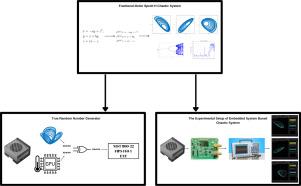基于分数阶Sprott H混沌系统的真随机数发生器设计及统计验证
IF 2.5
3区 工程技术
Q3 COMPUTER SCIENCE, HARDWARE & ARCHITECTURE
引用次数: 0
摘要
对安全通信系统日益增长的需求强调了高质量熵源在密码学应用中的必要性。真随机数生成器(trng)从物理和混沌过程中获得随机性,对于确保物联网(IoT)、医疗保健和无线通信等领域的数据机密性至关重要。本研究提出了一种基于分数阶Sprott H混沌系统(FOSHCS)的新型TRNG架构,这是一种以前未在TRNG设计中使用的模型。通过分岔图、最大Lyapunov指数(MLE)和吸引子投影对FOSHCS的混沌特性进行了严格评价,证实了其作为可靠熵源的可行性。该系统在NVIDIA Jetson AGX Orin平台上物理实现,使用定制设计的DAC电路来观察模拟域中的混沌轨迹。此外,将实时GPU温度数据与混沌输出相结合,增强了熵的多样性。生成的比特流经过标准的统计随机性测试,包括NIST SP 800-22、FIPS 140-1和ENT测试套件,均成功通过。分数阶混沌建模与物理熵收集的集成使开发适合嵌入式和安全关键应用的紧凑高熵TRNG成为可能。据我们所知,这项工作代表了基于FOSHCS的TRNG的第一个硬件实现,为安全和鲁棒随机数生成提供了一个有希望的新方向。本文章由计算机程序翻译,如有差异,请以英文原文为准。

True random number generator design based on the fractional-order Sprott H chaotic system with statistical validation
The increasing demand for secure communication systems has emphasized the necessity of high-quality entropy sources in cryptographic applications. True Random Number Generators (TRNGs), which derive randomness from physical and chaotic processes, are essential for ensuring data confidentiality in domains such as the Internet of Things (IoT), healthcare, and wireless communication. This study presents a novel TRNG architecture based on the Fractional-Order Sprott H Chaotic System (FOSHCS), a model not previously employed in TRNG design. The chaotic properties of FOSHCS were rigorously evaluated through bifurcation diagrams, the maximum Lyapunov exponent (MLE), and attractor projections, confirming its viability as a reliable entropy source. The system was physically implemented on an NVIDIA Jetson AGX Orin platform using a custom-designed DAC circuit to observe the chaotic trajectories in the analog domain. Furthermore, real-time GPU temperature data was incorporated with the chaotic output to enhance entropy diversity. The resulting bitstreams underwent standard statistical randomness tests, including the NIST SP 800-22, FIPS 140-1, and ENT test suites, all of which were successfully passed. The integration of fractional-order chaotic modeling with physical entropy harvesting enabled the development of a compact and high-entropy TRNG suitable for embedded and security-critical applications. To the best of our knowledge, this work represents the first hardware realization of a TRNG based on the FOSHCS, offering a promising new direction in secure and robust random number generation.
求助全文
通过发布文献求助,成功后即可免费获取论文全文。
去求助
来源期刊

Integration-The Vlsi Journal
工程技术-工程:电子与电气
CiteScore
3.80
自引率
5.30%
发文量
107
审稿时长
6 months
期刊介绍:
Integration''s aim is to cover every aspect of the VLSI area, with an emphasis on cross-fertilization between various fields of science, and the design, verification, test and applications of integrated circuits and systems, as well as closely related topics in process and device technologies. Individual issues will feature peer-reviewed tutorials and articles as well as reviews of recent publications. The intended coverage of the journal can be assessed by examining the following (non-exclusive) list of topics:
Specification methods and languages; Analog/Digital Integrated Circuits and Systems; VLSI architectures; Algorithms, methods and tools for modeling, simulation, synthesis and verification of integrated circuits and systems of any complexity; Embedded systems; High-level synthesis for VLSI systems; Logic synthesis and finite automata; Testing, design-for-test and test generation algorithms; Physical design; Formal verification; Algorithms implemented in VLSI systems; Systems engineering; Heterogeneous systems.
 求助内容:
求助内容: 应助结果提醒方式:
应助结果提醒方式:


